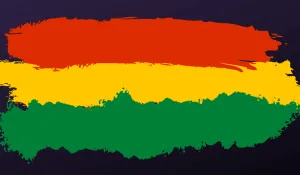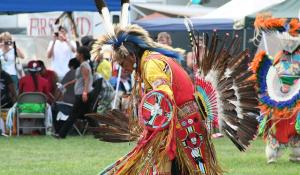
1844
A Creek Indian mother and grandmother,
Sally Ladiga, fights for her land and wins a
Supreme Court case.
1924
Zitkala-Ša of the Yankton Dakota Sioux leads a
voting registration drive for Native Americans.
1961
Armed, women of the Northwest Indian Nations made up half of arrested protesters during
fish-in protests.
2021
Attorney and member of the Couchiching First Nation, Tara Houska, is violently arrested for trespassing while protesting the Line 3 oil pipeline.
What these environmental acts of resistance have in common is that Indigenous leaders and communities were at the helm—and women are their invaluable leaders.
“I’ve always been involved in community organizing in some way, shape, or form since I was a teenager,” Joye Braun says.
Braun is a member of the Cheyenne River Sioux Tribe and currently serves as the national pipelines campaign organizer for the Indigenous Environmental Network’s. She was actively involved in the Keystone XL Pipeline protests.
“Local activism can change so many things,” she enthuses. “You can make a lot of waves locally, you don’t need a lot of people.”
In July 2021, the people of Rapid City, South Dakota staged a protest led by the NDN Collective.
“The city has made it almost impossible for any small organization to get any kind of permit, so we just take over the sidewalk,” says Braun. “Having, you know, 200-300 people lined up in a state like South Dakota is pretty significant. We made national headlines.”
Historical Trauma: The Root of Activism
Acts of resistance became a refrain for Indigenous tribes following colonization and the bloody establishment of the United States. One of the earliest was in response to the Indian Removal Act of 1830, which was a law passed by President Andrew Jackson ordering the resettlement of Native people to the west of the Mississippi. Jackson ultimately signed 70 removal treaties into law, forcibly moving numerous tribes, beginning with the Cherokee, Creek, Chickasaw, Choctaw, and Seminole, away from their homelands.
The Cherokee Nation condemned the Act and challenged it in court. Two years later, in 1832, the Supreme Court in Worcester v. Georgia determined the Cherokee had a right to their land and political independence. Despite the ruling, Jackson also forcibly removed the Cherokee Nation and by the 1840s, there were no Native American Nations in the American South.
Modern activism is rooted in historical trauma, says Dr. Natalie Avalos, who is a Chicana of Apache descent and a professor of ethnic studies at the University of Colorado Boulder.
“Historical trauma as a conversation has been percolating for a long time, but it has become more salient as younger generations have become hyper-aware of just how impacted they are by this kind of trauma,” Avalos says. “One of the means folks are using to try and work through and heal some of that trauma is coming together for [Indigenous] self-determination. Protecting your water, protecting your land becomes unifying points.”
For Bernadette Demientieff, a member of the Gwichyaa Zhee Gwich’in Tribal Government in Fort Yukon, Alaska, and director of the Gwich’in Steering Committee, Avalos’ explanation rings true.
Since “time immemorial,” Demientieff says her people have had a spiritual and cultural connection to a caribou birthing place called Iizhik Gwats’an Gwandaii Goodlit, or the “Sacred Place Where Life Begins.”
“We made a vow to take care of them and for 40,000 years we migrated alongside them, until the government forced us to settle.”
The Gwich’in people settled along the caribou’s migratory route, where they take the steps they can to preserve their history and culture against government actions. More recently, Gwich’in people have been leaders in the fight against the Line 3 oil pipeline construction, which is set to weave through Indigenous lands in Canada, Minnesota, and Wisconsin.

Matriarchs on the Frontlines
The fight for the Earth’s revitalization is deeply embedded in Indigenous women, who are seen as powerfully spiritual and revered figures in many Native American nations.
“The work Indigenous women are doing on the front lines is no surprise,” explains Avalos. “For many Native nations, the idea that women have this sacred, procreative power lends them to intuitive knowing on how to care, how to heal, how to rectify, and at times even be wrathful and powerful and create boundaries.”
Braun believes the power of women as community organizers and activists is not only traced to Indigenous cultures and beliefs, but again back to historical trauma.
“After a long time of patriarchal rule, marginalized people get left behind when it comes to these fights—climate fights, justice fights,” Braun says. “Because of that, we have a connection that white men are never going to have.”
Demientieff shares that grief roots her in her work every day.
“I lost my son to murder in November 2019. It’s heartbreaking,” Demientieff says. “I realized that our children, they have every right to clean water, they have every right to clean air, to healthy animals to hunt. And I will fight for that every step of the way. I will fight for that for my grandchildren.”
Her people didn’t go looking for a fight, but her children are worth fighting for, she explains.
“That’s why there are women standing up speaking. We understand the importance of Mother Earth.”
Listen to Native Women—and other Actions to Take
To support Indigenous women and the causes they champion, Avalos says there is a foundational first step: truth and reconciliation, which she talks about with her students.
“We have one week where we talk specifically about gender justice and Missing and Murdered Indigenous Women [MMIW], and they’re always shocked and horrified by the numbers and the stats,” she explains. “The level of violence that Indigenous women experience is often invisible. And if it’s invisible, then you can’t do anything about it.”
Her advice for white allies is to learn about the plights Indigenous people have faced and continue to face, and then tell their friends and family about what they’ve learned. What’s so important about this is having Indigenous people’s historical and current traumas witnessed and acknowledged.
Listening, as a first step, can make big impacts.
“Having people come in making decisions about our future and not involving us is disrespectful, and, quite frankly, violating our human rights,” Demientieff states.
What follows—the action—is even more powerful:
“We have to have more people involved, we have to have more people speaking out,” she says. “We have to have more people standing as one because who wants to see one star in the sky? You want to see a bright and shining sky, and that’s the way I see community organizing. Be loud, be proud, because we’ve come from some of the strongest people that ever walked this planet.”
Look where you live—there is likely a Native community closer than you think. There are many things you can do to support your Indigenous neighbors.
Helpful actions you can try:
- Buy from Native-owned businesses
- Support Native-led organizations like the Indigenous Environmental Network by donating or showing up to events
- Learn about whose land you occupy
- Listen to their stories and priorities
- Pay voluntary land taxes: learn more at nativegov.org
- Respectfully attend public-facing events
- Seek consent for land usage—you can read more about prior, informed consent from Native scholars Carla F. Fredericks and Kate R. Finn.
“As far as my people are concerned, I’ve already faced mass genocide, loss of land, and loss of language and culture,” Braun says. “If we can come back, then the world has an opportunity to as well.”

Dr. Avalos’ Syllabus
Check out Dr. Avalos’ recommended articles and books for further reading on Indigenous activism:
- “Indigenous Stewardship and the Death Rattle of White Supremacy,” an article by Dr. Avalos at politicaltheology.com
- “Recovering the Sacred” by Winona La Duke
- “Our History Is the Future: Standing Rock Versus the Dakota Access Pipeline, and the Long Tradition of Indigenous Resistance” by Nick Estes







